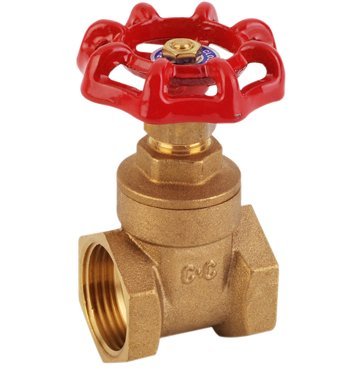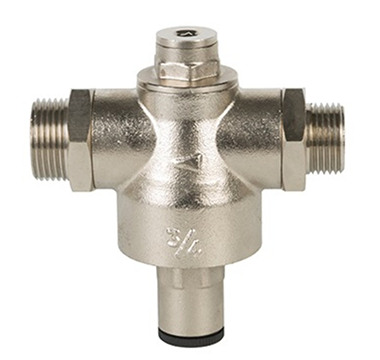In the intricate network of residential plumbing systems, water valves play a crucial role in controlling the flow, pressure, and direction of water. From the main shutoff to individual fixtures, various types of water valves are strategically placed to ensure smooth operation and efficient distribution of water throughout the home. Understanding the different types of water valves used in residential plumbing can help homeowners better manage their water supply and respond effectively to maintenance or repair needs.
Gate Valve
Gate valves are stalwarts in residential plumbing, typically positioned near water meters or main shutoffs. Their mechanism involves raising or lowering a gate to control the flow of water. Click to learn more.
Here are some common uses of gate valves in residential plumbing:

(1)Main Shutoff Valve: Gate valves are often installed as the main shutoff valve where the water supply enters the home.
(2)Isolation Valve: They may be installed to isolate the water supply to a particular bathroom or kitchen, making it easier to work on plumbing fixtures without disrupting water flow to the rest of the house.
(3)Large-Diameter Pipelines: Gate valves are suitable for use in larger diameter pipelines where high flow rates are required. They can handle substantial flow volumes and are less prone to pressure drop compared to other types of valves, making them ideal for applications such as main water supply lines or irrigation systems.
(4)Low-Pressure Systems: In residential plumbing systems with lower water pressure, gate valves are often preferred due to their ability to provide a full bore flow path when fully open. This minimizes pressure drop and ensures efficient water distribution throughout the system.
(5)Fire Protection Systems: Gate valves are commonly used in residential fire protection systems to control the flow of water to fire sprinklers or hydrants. They are designed to provide reliable operation even under high-pressure conditions and are crucial for ensuring the effectiveness of fire suppression measures in residential buildings.
Ball Valve

Ball valves are known for their reliability and quick operation. Featuring a spherical disc inside the valve body, they control water flow by rotating the handle perpendicular to the pipe to close the valve or parallel to open it. Learn about product models, materials and prices.
Here are some common uses of ball valves in residential plumbing:
(1)Main Shutoff Valve: Ball valves are often installed as the main shutoff valve where the water supply enters the home. Their simple operation, with a quarter-turn of the handle to open or close the valve, makes them ideal for quickly and effectively shutting off the water supply in case of emergencies or when performing maintenance or repairs.
(2)Isolation Valve for Fixtures: They may be installed on supply lines to sinks, toilets, washing machines, and outdoor faucets, allowing homeowners to shut off water to individual fixtures without affecting the rest of the plumbing system.
(3)Appliance and Equipment Control: Ball valves are commonly used to control the flow of water to appliances and equipment in residential settings. This includes water heaters, water softeners, filtration systems, and irrigation systems.
(4)Outdoor Plumbing Applications: Due to their durability and resistance to corrosion, ball valves are often used in outdoor plumbing applications, such as hose bibs, outdoor showers, and sprinkler systems. They can withstand exposure to harsh weather conditions and are less prone to damage from external elements compared to other types of valves.
Stop Valve (Angle Valve)
Stop valves, also known as angle valves, are indispensable for controlling water flow to individual fixtures such as sinks, toilets, and faucets. Stop valves provide a convenient way to isolate fixtures for maintenance or repair without disrupting water supply to the entire house. Learn about product models, materials and prices.
Here are some typical applications of stop valves in residential plumbing:

(1)Fixture Shutoff: Stop valves are often installed near individual plumbing fixtures such as sinks, toilets, and faucets. They serve as convenient shutoff points, allowing homeowners to isolate specific fixtures for maintenance, repairs, or replacements without disrupting the water supply to the entire house.
(2)Supply Line Control: Stop valves are frequently used to control the flow of water through supply lines to various fixtures and appliances in the home. For example, they may be installed on supply lines to hot water heaters, dishwashers, and washing machines, enabling homeowners to shut off water flow to these devices when needed.
(3)Emergency Shutoff: In addition to their role in routine maintenance and repairs, stop valves also serve as emergency shutoff valves in residential plumbing systems. By quickly closing the valve during a plumbing emergency such as a burst pipe or a water leak, homeowners can minimize water damage and mitigate potential flooding within the home.
(4)Fixture Installation: Stop valves are commonly installed during the initial installation or replacement of plumbing fixtures in residential properties. They provide a convenient means of controlling water flow to newly installed fixtures, allowing for easier installation and testing of the plumbing system.
(5)Toilet Installation: In particular, stop valves are essential components of toilet installations. They are typically located on the supply line connecting the toilet tank to the water supply. Stop valves allow for easy maintenance and repairs of toilets by enabling homeowners to shut off water flow to the toilet without affecting other fixtures in the bathroom.
Check Valve

Check valves serve a critical role in preventing backflow by allowing water to flow in only one direction. They find applications in sump pumps, water heaters, and irrigation systems to ensure that water flows as intended and does not back up into the plumbing system, thereby safeguarding against contamination and damage. Learn about product models, materials and prices.
Here are some common applications of check valves in residential plumbing:
(1)Preventing Backflow: One of the primary purposes of check valves is to prevent backflow of water in residential plumbing systems. They ensure that water flows in only one direction, preventing contaminated or used water from flowing back into the clean water supply.
(2)Sump Pump Systems: Check valves are commonly used in sump pump systems installed in basements or low-lying areas prone to flooding. They prevent water from flowing back into the sump pit once it has been pumped out, helping to maintain the effectiveness of the sump pump and preventing flooding in the basement.
(3)Water Heater Systems: Check valves are often installed on the hot water outlet of water heaters to prevent backflow of hot water into the cold water supply line.
(4)Irrigation Systems: Check valves are integral components of residential irrigation systems, ensuring that water flows in only one direction through the irrigation pipes.
(5)Boiler Systems: In homes with boiler systems for heating, check valves are used to prevent backflow of water from the heating system into the main water supply. This ensures that the water in the heating system remains separate from the potable water supply, preventing contamination and maintaining system efficiency.
Pressure-Reducing Valve (PRV)
Homes with high water pressure benefit from pressure-reducing valves (PRVs), which regulate water pressure to a safe level. By reducing excessive pressure, PRVs help protect plumbing fixtures, appliances, and pipes from potential damage, prolonging their lifespan and ensuring efficient water usage. Learn about product models, materials and prices.
Here are some common applications of pressure-reducing valves in residential plumbing:

(1)Protecting Plumbing Fixtures: PRVs are installed at the point where the main water supply enters the home to reduce excessively high water pressure. High water pressure can cause damage to plumbing fixtures, such as faucets, toilets, and pipes, leading to leaks, bursts, and premature wear. By reducing the pressure to a safe level, PRVs help to protect these fixtures and extend their lifespan.
(2)Preventing Water Hammer: Water hammer occurs when high-pressure water flow is suddenly stopped or redirected, causing a shock wave that can damage pipes and plumbing components. PRVs help to mitigate water hammer by maintaining a steady and controlled water pressure throughout the plumbing system, reducing the risk of sudden pressure spikes.
(3)Conserving Water: Excessive water pressure not only damages plumbing fixtures but also wastes water. High-pressure water can cause faucets and fixtures to leak or drip, resulting in unnecessary water consumption. By reducing the pressure to a more moderate level, PRVs help to conserve water and promote efficient water usage in residential properties.
(4)Protecting Appliances: Household appliances, such as washing machines, dishwashers, and water heaters, are designed to operate within a specific pressure range. Excessive water pressure can cause these appliances to malfunction or fail prematurely. PRVs ensure that the water pressure supplied to these appliances is within the manufacturer’s recommended range, protecting them from damage and ensuring optimal performance.
(5)Maintaining Comfort: High water pressure can also affect the comfort of residents by causing excessive water flow and noise from faucets and showerheads. By reducing the pressure to a more comfortable level, PRVs help to create a more pleasant and enjoyable water experience for residents, with consistent flow rates and reduced noise levels.
Thermostatic Mixing Valve (TMV)

Thermostatic mixing valves (TMVs) play a crucial role in maintaining a consistent and safe water temperature at fixtures such as showers and faucets. By blending hot and cold water to achieve the desired temperature, TMVs help prevent scalding and ensure comfort and safety, particularly in households with young children or elderly residents.Learn about product models, materials and prices.
Here are some common applications of thermostatic mixing valves in residential plumbing:
(1)Preventing Scalding: TMVs are installed at hot water outlets to blend hot water with cold water, ensuring that the water temperature remains within a safe range to prevent scalding. This is particularly important in homes with young children, elderly residents, or individuals with limited mobility who may be more vulnerable to burns from hot water.
(2)Shower Temperature Control: TMVs are commonly installed in shower systems to regulate the water temperature and prevent sudden fluctuations in temperature during use.
(3)Faucet Temperature Control: TMVs are also used in faucets throughout the home to regulate the water temperature at sinks and basins.
(4)Bath Temperature Control: In baths and tubs, TMV help to maintain a comfortable and safe water temperature for bathing.
(5)Compliance with Building Codes: Many building codes and regulations require the installation of TMVs in residential properties, especially in new construction or renovations. These regulations are designed to protect residents from scalding injuries and ensure that the water temperature remains within safe limits throughout the home.
In conclusion, the diverse array of water valves used in residential plumbing systems reflects the complexity and precision required to manage water distribution effectively within a home. Whether it’s controlling flow, preventing backflow, regulating pressure, or maintaining temperature, each type of valve serves a specific function in ensuring the reliability, safety, and efficiency of the residential plumbing infrastructure. Understanding these different types of water valves empowers homeowners to make informed decisions and take proactive measures to maintain their plumbing systems.


